Elizabeth R. Andersen's Blog
February 21, 2023
What three uncouth women taught me about post-pandemic life
When I set out to write my first historical fiction saga, The Two Daggers, I had a story to tell. I wanted to immerse myself and my readers in action, adventure, new places, and a pivotal historical event. And the readers who love that series really love it (many thanks to them because it takes a few chapters for the action to start rolling in book 1). There's nothing more amazing to me than reading the series reviews and realizing that I wrote a story that people like. It's surreal.
But when I set out to write my second series, The Alewives of Colmar, I was not thinking about action or adventure. I wrote it because I couldn't see any light through the darkness in my own life.
We had been in the full grip of the pandemic for a year, and I, like every other parent on the planet, felt panicky and hopeless. Worrying about the world that my son and his peers would one day inherit was too much to grasp. I could barely manage to wrap my mind around how I would make it through 8-hrs of daylight while trying to juggle his remote learning, my full-time tech job, a massive home remodel, and a half-finished series about 13th-century Palestine. Some days I couldn't even remember how to put one foot in front of the other, so I just sat still a lot (anyone else who also has ADHD understands how remarkable it is to sit still). I kept wondering how people put their lives back together after other pandemics in history. How on earth could we try to have normalcy again...and should we even try?
This question led me to look closely at the years immediately following the Black Death in the 14th century - not because I was interested in writing a novel about that time, but because I needed guidance. One of the deadliest pandemics in history, some estimate that the the Black Death (also known as the Plague or the Pestilence) decimated a third of the world's population between the years of 1348 and 1352 (note: this is a euro-centric estimate. Like our own pandemic, there's no real definitive start/end date). Entire governments and economic systems collapsed. Wars began. Dynasties ended. Sound familiar? I certainly thought so. How did people come to terms with their new normal after surviving something like that, and could we learn anything from it in our modern lives? Despite being 700 years apart, there were similarities between what happened then and what is happening now. It only took a few days of research into the post-Black Death timeline for me to realize that I needed to write a book about those years when the few remaining citizens of the world had to dust themselves off and get back to the business of living.
The Alewives was, by far, the most challenging book I've tried to write. The length and the amount of historical research had nothing to do with my struggle to bring it to life. I knew this book needed to be light and humorous, and it was so hard to find that within myself. After multiple rewrites, I finally gave in and decided to let Gritta, Appel, and Efi (my three main protagonists) take the helm. As it turns out, I wasn't feeling strong or brave, but they were. As soon as I released control and let the characters write themselves, I began to see how special they were…and how familiar. They are not words on a page; they are an amalgamation of every woman who has come into my life in my 42 years. The alewives are every bout of laughter I've had with my girlfriends on a Friday night, and they are every heart-wrenching hour of grief or sadness where we've had our arms around each other and tears fall freely. Each petty argument followed by a grudging apology, every long phone call or internet meme shared - that is who the alewives are. Writing them was like rediscovering something I had lost and didn't even know I had missed: sisterhood.
After a few weeks of the book being out in the wild, the reviews and reader emails began to appear in my inbox and on my book's product pages. Approaching them with my usual caution, steeled nerves (and a full glass of wine), what I found was astonishing. My readers told me that the three alewives of Colmar gave them a respite, a laugh, and a puzzle to solve. These heartfelt notes from people who enjoyed the book are worth more to me than sales numbers and royalties.
Now, the tech job is gone, the child is back in school, the home remodel is (mostly) finished, and The Alewives is out in the wild. I no longer think that what transpired after the Black Death can be used as a guide for us now - at least, not in a concrete way. The collapse of feudalism in the 15th century is not a guide for how the countries of the world will adjust to their new reality in the 21st century. The surge in crime after the Plague bears little resemblance to our own troubles with war and violence now. The things that connect us to those survivors of 700 years ago are more intangible; collective trauma on a global scale? Absolutely. But there's something else, and that is our ability to find strength by building each other up. After years of being afraid to breathe the same air as our neighbors, we're now cautiously reaching out to touch each other and remember the feeling of warm bodies in an embrace and the joy of shared laughter. Sisterhood and brotherhood will never go out of style.
September 13, 2022
Dispatch from Durham
Once again, I found myself strapped into a seat, feeling the weight of my body press backwards as the plane full of people accelerated to 160 mph and broke free of the surface of the earth. Only three weeks before, I had arrived home from four weeks of traveling through Italy for a vacation, followed by two weeks in France to research my new series. Now I was aloft once more, heading back across the Atlantic from Seattle to the UK in order to attend the Historical Novel Society’s annual conference in Durham, in the northeast corner of England. Many of my American author friends were perplexed by this decision, after all, it was expensive and a long distance to travel. I would only be gone for six days, three of which were taken up entirely with transport on planes and trains, and there were only about a hundred registered attendees. Even historical fiction authors in England had a difficult time justifying the distance and price. So why did I go? For me the answer was easy: for the people.
All authors work alone, but indie authors are even more isolated than most. Without agents and publicists to cheer us on, we rely heavily on the community of other authors for emotional support, encouragement, writing help, and a good kick in the pants when such a thing is required. In my work, people are my most valuable asset, the most effective marketing tool, the best publicists, and the highlight of my journey into this world of writing. Without the support and encouragement of other authors, I would have given up after I read my first 1-star review. I am still a new(ish) author, but I’ve already had chances to give back to those who are coming behind me, and it’s a good feeling. I traveled halfway across the world because it was a privilege and a joy to meet with these authors.
Because this group leaned heavily toward Roman, Medieval, and Renaissance authors, the choice of the great hall in Durham castle for our dinner was fitting. We had some amazing musical performances, including my first experience ever hearing the Northumbrian pipes, a very old instrument that resembled (but is different than) the highland bagpipes.


The conference sessions were amazing. Our first day keynote by Emma Darwin (yes, that Darwin. She is his great granddaughter) was inspiring. I was challenged by Dr. Laura Tisdall’s interpretation of historical fiction as a genre that could be written about last week, as long as it is treated with the reverence of history and not just a recollection of a memory (fighting words, I know. Dr. Tisdall is lovely, so be nice). One of my favorite sessions was a multi-speaker presentation from the medieval studies department at Durham University on the topic of food. Any readers who follow me on TikTok will know that the history of food fascinates me. Professor Daniel Newman (EatLikeASultan.com), from the Medieval Islamic studies department, lectured on one of my favorite topics: Medieval Islamic food. He even brought cookies for the audience. Dr. Amanda Herbert (BeforeFarmToTable) gave a fascinating lecture on the migration of food across continents. Where else could you go to an international conference and be given cookies? All of this was to prepare us for our dinner at Blackfriars Restaurant in Newcastle, where we were treated to a traditional medieval feast in a room that was used by King Edward III in 1334. The menu was arranged in cooperation with the restaurant staff and Florence Swan, who studies transmission of taste at the university and joined us for our meal.



On our last day, we heard from Graeme McRae Burnett, whose historical murder mystery thriller has become a finalist in several prestigious awards, and then the two days of conferences were over. I left with my brain and my cell phone buzzing from all of the ideas and friends I had met. Authors can be solitary creatures. It wasn’t always easy to socialize and be brave in such a small group, but I don’t regret my decision to go. I would travel halfway around the world to meet with these amazing people again.

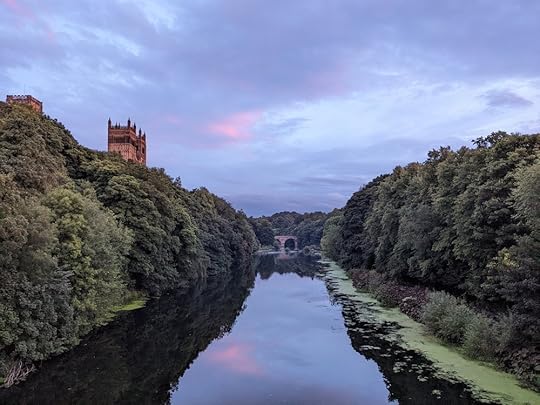


Note: if you are a historical fiction author looking for a great community of like-minded colleagues, consider joining the Historical Novel Society , and if you are simply someone who enjoys reading historical fiction you can join too! The next conference will be in San Antonio, TX in the summer of 2023. Come find me - I will be there!
~E.R.A.
June 1, 2022
Using your powers for good
Sometimes, after I walk my little boy to his primary school in the mornings, I will continue on past my house and down the hill to my gym. The path takes me through a wetland that has been lovingly preserved for beavers, coyotes, otters, and all kinds of wild birds. It is a tranquil place despite the busy road on the other side of the marshy fields, and the wide boardwalk is a popular place for dog walkers, bird enthusiasts with telescope lenses on their cameras, joggers, and parents teaching their children to ride bikes. This trail is heavily used by the community, and because of our chilly, damp spring, the verge has been particularly vibrant this year. The large, velvety leaves of Thimbleberry bushes are soft to the touch, various types of willows drape their branches over the paths, and leathery salal plants vie for space against Oregon grapes and salmon berry plants. And our Pacific Northwest nemesis is also here: the Himalayan Blackberry. We don’t mind them in mid-summer when the tangle of razor-sharp vines are full of delicious purple berries, but at all other times of the year, most of us are engaged in a battle to the death with this invasive species.
As I walked along the path this morning to my gym, someone, it seems, took the battle to the blackberries in the park, lopping off swaths of vines that had been reaching out into the path to grope passersby with their painfully spiky grip. I appreciated that a citizen cut this nuisance back from the path, but instead of cleaning up their mess, they left clumps of limp blackberry vines laying in piles where people walked and rode their bikes. I stepped over them on my way to the gym, and expected that they would be gone by the time I returned, but an hour later they were still laying there.
Rather than step over them this time, I started to sweep the vines off the path and into the ditch with my foot. It wasn’t ideal - after all, those vines could put down a root and become a new blackberry bush (don’t believe me? Try being a Northwest gardener sometimes to understand the Himalayan Blackberry’s ferocious battle for survival which defies poison, shovels, weedwhackers, and even goats. Yes, we rent goats to eat our blackberries.)
It was then that I heard a scraping noise behind me. Another man on the path had followed my lead and was doing the same thing, kicking the vines out of the way. Then a couple walking toward me saw what we were doing and they began to shove the piles of leaves and vines off the path, and in less than two minutes it was clear for the bikers and walkers. If you are reading this, here is what you should take from it: doing the right thing is contagious.
This made me think about writing, because I think about nothing else these days. As an independent author, I have to do everything by myself: I designed this website and blog. I had to set myself up as a publisher, lay out my books, hire editors and cover designers, and on and on. But although I am doing all this stuff by myself, it doesn’t mean that I am alone. After years of slogging away through research and writing in almost complete isolation, I did what most writers hate to do, and “put myself out there.” That is to say, I started spending time in my week making friends with other authors and engaging with them on social channels and in conferences. Every connection with a new author leads to a new opportunity, but not just for myself - for the whole community.
Now that I am starting to feel slightly more established, I have turned my mind to ways that I can help other authors. Writing is competitive, and we see each other out there, all struggling together to be noticed among the hoards of other competition. Sometimes we treat each other like that vine-strewn path: we step over the problems and assume that someone else will come along and do the right thing. We see the struggling author who is just starting out and think “thank God that’s not me any more.” Or sometimes we tell ourselves that we are being altruistic, but truly expect someone back in return, such as when we review another author’s work or follow them on social media with the expectation of an equal reciprocal action. Doing the right thing means putting yourself in another author’s shoes and expecting nothing in return.
It’s hard to find the time in between writing, editing, marketing, and the relentless drumbeat of social media to remember to hold out a hand to another author in need, so I schedule it, usually for Wednesdays, and usually for an hour. In that hour, I write book reviews, comment on new social media accounts, and my all-time favorite activity; write fan mail telling other authors if I liked their books. Sometimes I share blog posts by other authors on my Twitter feed, or promote another’s work on my Instagram without being asked to first. What do I get in return? Immense joy knowing that I might have made someone else’s day.
I encourage you to do the same for an author, or other artist that you appreciate. Books, paintings, sculpture, music, and all other kind of art are intensely personal to the individual who created them. If their works speaks to you, tell them! You may not think you have much to offer, but if you can encourage someone or give them a lift, then in my book, you are powerful. Please use your powers for good.
~ E.R.A.
April 8, 2022
“How many books have you sold?”
I blinked at her as her words filtered into an unused part of my brain.
How many books have I sold?
She was looking at me in her perfect way - the hair: perfect. The makeup: barely there but just enough. The outfit: A silk blouse and unattainable leather pants. She was a remnant of my past, when I lived in the world with other people; when I was that well-dressed, successful woman who was in charge. I looked down at myself: I was sipping my second glass of wine when everyone else at the table was tactfully working through their first one. My fuzzy sweater kept shedding hairs of maroon wool into my eyes and making me blink myopically. My jeans were the wrong color and shape. I had walked out of the house and into a bar looking like this and barely noticed, because my head was miles high in the clouds, dreaming up plotlines and character profiles.
There was a moment of panic and then realization that it was going to be ok. I remembered myself - not the corporate self, but the self that had been hiding for years.
The question, posed by a very successful woman who works in the financial industry, was asked innocently. She is lovely (I mean lovely inside, but it doesn’t help that she was also stunning on the surface, too), and she meant no malice whatsoever. She was just trying to put me in context next to what she knew: numbers, ratios, comparisons, positives and negatives. This is the world she lived in, and at one time, it was a world I lived in as well.
For weeks, her question didn’t sit well with me, but I couldn’t put my finger on why. I have absolutely nothing against her - like I said, she’s a lovely person. Taking her in context, her question made sense. At the time, I was only a few months past my resignation from one a major Seattle-based tech company, and still used to only measuring success in dollars and ad-clicks. But there was something else that kept chewing on my edges and I couldn’t figure out what it was.
And then I realized, it was me. I had sold out.
No, not now - I sold out early in my career. In my early twenties I was a much better writer, but I had no life experience. I wish I could say that I had the wisdom to see this at the time, but actually, I was facing homelessness and so I took the first well-paying job that was offered to me and kissed my dreams goodbye. Years of success followed by self-sabotage ensued.
When I finally decided to leave my well-paying job that was psychologically satisfying and monitored by a wonderful manager who supported me emotionally, I willingly joined the chorus of people who muttered that I was probably having a midlife crisis. I was more aware than most how ridiculous my decision was - after all, I had grown up feeling financially insecure, so it had always been my prerogative to make sure that my finances were plush and stable. So why did the question about how many books I had sold bother me so much? Why did I not know the answer? Why hadn’t I tracked every single half-cent of Kindle Unlimited page reads and royalties on paperbacks (printing and shipping costs removed, of course).
Back at that bar, I stuttered out an excuse to her and then looked at my Amazon dashboard to see how many books I had actually sold. The verdict: I had sold 81 books.
I’ll admit, there is a jaded side of me that suspected it wasn’t possible to get a traditional publishing deal with a well-known firm unless you were sleeping with someone high up. Then I learned more about how the publishing (and book-pitching) industry actually works and recognized that no amount of sexual favors can produce cold, hard cash like a bestseller. I learned how little money traditionally published authors make, unless they are the unicorns, like Stephen King or Danielle Steel. And then I got to the nugget of my ire. This is why I was so unnerved by the question from this well-meaning woman.
I was not tracking how many copies I had sold because I viewed my writing as an art form. Does a true artist really pay attention to ratings, sales percentages, and downloads? Well… yes. I was so exhausted from my corporate life, that I thought writing would be a kind of respite. I no longer needed to count impressions/beans/likes/quarterly reports like I did in my previous role. I could be free to just create in a cocoon of sticky self-love and affirmation.
Nope!
I am an independent author. Why? Not because I couldn’t get a traditional publishing deal. I didn’t even try. I am independently published because I am impatient. I don’t want to give up extra royalties that go to publishing houses. I don’t want to be “told” what to write. Ok, well, for the right price, perhaps I will, but at this moment, I’m loving the freedom that comes with being independent. I wrote a historical fiction epic about 13th century Palestine when the only historical fiction that Americans feel like reading at the moment are stories of brave women overcoming the odds during WWII or the stories of brave women living large during the roaring twenties. Perhaps I will decide to start writing to market when I get tired of noticing that my monthly royalty check doesn’t even amount to a single day’s salary in my old job, but for now, I am not checking how many books I’ve sold, and the next person who asks is going to get the full lecture about the reason for my choice. Even though I have to manage my own marketing, taxes, travel costs, layout, book covers and on and on, this is still a respite from twenty years of working for a tech billionaire.
That feeling of freedom is worth more to me right now than enough book sales to make it on the New York Times bestseller list.
March 11, 2022
My son’s giant, autistic heart

I was in the kitchen when I heard it, the wail rising from the basement. I heaved a sigh. With my 9-year old son, a meltdown was almost a daily occurrence. Hurrying down the steps, I ticked off the possible reasons for his outburst: Was he accusing his father of cheating at the game they played? Was there a loud noise? Was his mind overwhelming him?
Earlier that day, when I picked him up from school, one of the moms tried to speak with him. He turned his face away from her and looked over his shoulder. I used to think he was just being coy until I knew better. I gently prompted him to answer her questions as she kindly explained that he was invited to a birthday party. I suspected that he had been invited out of pity, but I didn’t care: When you are the mother of an autistic child, you don’t say no to ANY overture of friendship. You can’t afford it.
Back to our basement. I found him, kneeling on the floor, hiccoughing with sobs.
“What’s wrong?” I asked, and he turned into me, rubbing his eyes.
“I can’t watch,” he moaned. “The mom dies!”
I looked up at the TV. He and my husband had been playing a video game and like a 21st century Bambi, the cut scene showed the tragic aftermath as a child realized their mother was dead. My little boy wrapped his arms around my waist and buried his face in my sweatshirt. He let me lead him into another room, but he did not let go of me.
“Look,” I said, dragging his massive mythology book from a shelf. “Did you know that this book has myths from Pacific Islander culture? Those are my people, and yours too! Let’s read together!”
He sniffed and sat on my lap. This 9-year old, who is almost as tall as me can barely fit on my lap any longer. He hugged me again, and said he didn’t want to learn any Polynesian myths.
“It’s one thing to read about death, Momma,” he said, his voice trembling, “but it’s something else to see it. It’s just…” and he broke off again, crying and I mentally rehearsed the scolding that his unwitting father was about to receive.
I don’t like to talk about his autism. When we first received his diagnoses, it was the only thing I wanted to talk about. Finally, someone mentioned that they thought I used it as an excuse for his “bad manners.” That was the moment I realized that his life would be filled with misunderstanding, even though he had a clinical name for what was happening to him. For a long time, I hid it. I just wanted him to be treated like a normal kid.
But he isn’t normal, and that is the most wonderful thing about him.
Please, not another Sheldon comparison…
There is a common misconception that autistic people don’t have feelings. This isn’t new, but Sheldon Cooper, the so-called “Asperger’s” character from The Big Bang Theory definitely perpetuated that stereotype, and put fuel on the fire of people who aren’t interested in looking past the surface of kids on the autism spectrum. That character is portrayed as a narcissist without emotion or self-awareness. But here is what my autistic son is like. He is aware of EVERYTHING, and that includes the stigma associated with his condition, and with the way he is treated. My autistic child is the most caring, sensitive being I’ve ever known, who approaches every school day with anxiety and every social interaction as a game where everyone but him knows the rules. This kid is highly in tune with his environment…but his environment is either oblivious to people like him, or it makes them into a joke to sell a sitcom to a larger audience.
We will change if you change first
Eventually he calmed down, wiped his eyes, and skipped happily back into the room where his father waited. The upsetting scene with the dying mother resolved and my son seemed fine. But when I tucked him into bed, he grabbed my hand and squeezed.
“I always want to live with you and daddy,” he mumbled as sleep dragged his eyes closed. My heart swelled, and then broke. I want him to live with us forever too, but I know he can’t. I wish I could guard him through middle school and college like I do now that he is still a young boy - by reminding the other kids around him to be inclusive, by teaching him tricks for making it through each day, and rote memorization of manners.
The life ahead of my son is hard. Children like him - autistic, anxious, unable to interpret social cues - have a marginal place in our hyper-social environment, where social proof and follower counts are like currency. I am realistic about what he will experience as he grows up, and we are trying to teach him how to adapt without losing himself.
But I would be lying if I said I didn’t I want society to change first.

February 14, 2022
The mess behind success
The first email I read last Monday morning was from a book tour organizer, gently explaining that the book review I expected from a blogger would not be coming after all…because the reviewer couldn’t even finish reading my book. She couldn’t get through it.
Now, I am well aware of the faults in my first novel, and I really don’t want to be telling you all this. The embarrassment and horror that I feel is Everest-sized, and it comes after I had to rush the hand-off for the manuscript for book 3. It was a lousy way to start a week. Pouting ensued, and then soul-searching, contemplation of buying a bottle of wine, and eventually remembering that it was Monday and I was responsible for keeping a 9-year old little boy alive. My husband (who I also have to keep alive, because most days he walks out of the house with his shirt on inside-out) gave me a hug and then wisely kept his distance. Instead of writing anything, I folded laundry and contemplated a life in a different career.
There’s a point to this. A lot of discussion happens about how social media usage damages mental health, especially teenage girls. In a similar way, authors who are careful to never talk about their bad reviews and embarrassing mistakes - the typos that slip into print, or the days when not a single book sells - do the same to the rest of the community of authors. The life of an author is fraught with rejection and disappointment, and creating a false narrative of success doesn’t help anyone.
So, I am tentatively crawling out on this brittle limb to tell everyone that this happened: a book review that was supposed to go live last week was cancelled because the reviewer just couldn’t get into it. It doesn’t matter that I poured two years of my sanity, health, and what remained of my cold, shriveled heart into the book; it simply wasn’t good enough. And this is OK, because every single failure is an opportunity to learn and grow, even though I wanted to crawl into my bed and never come out again.
The first thing I did after this epiphany, was crawl into bed.
I took a handful of melatonin and when I woke up the next morning I was able to think clearly again. I remembered that two weeks ago I received an unexpected and wonderful email from a man who said that he absolutely loved the book. There are scores of reviews on Amazon, BookBub, and Apple Books shouting “these characters are complex but worth the wait!” And I reminded myself of something that I try to keep in mind when I am dealing with a difficult person: no matter what you may think about someone’s life or their successes (e.g. a writer whose first novel was signed to a major publishing company and then made into a Netflix series) we never know what is actually happening in people’s lives. It may look like perfection from our angle, but it’s a different story from theirs.
To you, dear readers, there isn’t much mystery. If something is happening, I tell people about it. This hasn’t always won me friends, but it is the truth of who I am. And readers, you will always know how I am. And right now, who I am is discouraged, hopeful, dreamy, and in love with life.
So, if you are an author feeling like you’re a serial failure at everything you’ve ever tried in your life, I am here to tell you that I AM TOO. And I am going to pick myself back up again and keep going truthfully. No PR team needed.
May you take joy and encouragement in my lousy Monday, and if you celebrate Valentine’s Day, I love you.
XOXOXO
E.R.A.
January 25, 2022
The bittersweet history of sugar in the middle ages
I was 9-years old, sitting in a car with my brother who had just turned 5. We were traveling from the house of my grandfather - who I had only met a few days earlier - through the Dole plantation fields in O’ahu on our way to Hale'iwa. My grandfather, who I would never see again after this visit, drove ahead of my parent’s rented car. My mom and dad were tense. My grandfather was not just a stranger to me, he was also a complete unknown for my dad, who last saw him when he was a small boy, living at his grandparents’ pineapple plantation in Aiea.
Grandpa Louie pulled his car to the side of a road next to a field of something that looked like tall, thick grass with woody stems and frilly tops. Taking a machete from his car (because apparently he always had one on hand) he chopped a piece of the purplish-green grass and handed it to me. Sugar cane.
"One end yours," he grunted in his local accent, "one end his," he pointed with the machete toward my little brother. The two of us sat in the back seat of the car, gnawing on our fibrous ends of the sugar cane to taste the sweet sap for the first time. I haven't looked at a candy bar the same way since.
In The Scribe, Henri of Maron lives on an estate with 21 villages that produce, lemons, cinnamon, and sugar. Because this was the 13th-century, there is a lot to learn about sugar and sugar production, as it differed in scope and importance from the 16th century, when production in the Americas caused an increase in supply and human misery. Sugar has a long and tragic history where it is connected to humans. I made a very short and awkward tiktok video about it if you want the short version of this post. If not, let’s dive right in.
How does sugar become sugar?
Sugar production is labor-intensive. The thick, fibrous stalks of the cane grow close together and have to be cultivated from existing stalks and the shoots planted by hand, similar to rice. Once the canes were grown and harvested, they are transported to a processing facility, pressed to release the thin, mildly sweet sap, and then boiled in to reduce the sap into a syrup that could be set out to dry. The process is essentially unchanged, although the tools and labor required are now quite different. In the 13th century, once the sap was sufficiently reduced, it was poured into a special cone-shaped mold that rested on top of a vase. The molasses dripped into the vase and the sparkling, brownish sugar cone was leftover.
As probably everyone is aware, sugar is very susceptible to dampness (have you ever tried eating cotton candy in the tropics?) so shipping it over long distances was impractical, as the cargo could easily become damp or spoiled in the cargo hold of a ship. Sugar is a finicky crop to grow; it wants a lot of water and a hot, humid climate. This limited the spread of the canes to a narrow band of the world, which excluded medieval Palestine until the Islamic Golden Age (approx. 8th - 13th centuries) produced Arab scientists and engineers who were able to create advanced irrigation techniques. FRom there, sugar cultivation spread to Egypt and Palestine. Things were rolling along sweetly until the arrival of Frankish crusaders in the 11th century, who had one taste and immediately became hooked. IN order to ensure that they had a safe supply of sugar that they could control, they planted crops on the island of Cyprus, and eventually the canes made their way to parts of Italy. By the 16th century, the production of sugar had ramped up in the Americas, resulting in the tragic and inhumane chattel slave trade, the consequences of this still hurt the world today.
Another consequence of growing and refining sugar that sometimes is overlooked is deforestation. It required enormous quantities of wood to stoke the fires and ensure that the copper pots of boiling syrup maintained the right temperature. In addition to forced labor for harvesting, pressing, and boiling the syrup, slaves were also put to work cutting and transporting wood from forests until there were no more trees left to cut.
A spoonful of sugar helps the sugar go down
Sugar was originally used as medicine, but its arrival in Europe was relatively late. Arab doctors had been using it for years as a way to help “warm the stomach” or assist with digestive issues. In 11th-century Europe, scribes finally translated Arabic medical texts into Latin (or, in some cases, back into Latin), which opened up a new world of scientific and medical knowledge previously unknown.
I can speak from my own experience about the effectiveness of sugar as an analgesic. When my son was 7-days old we discovered a strange bump under his arm. The emergency room doctors needed to lance it and culture whatever they found inside, but because my son was so little (he was born premature and still hadn’t reached his actual due-date yet) they did not want to give him anesthetics. Instead, he was given a little pipette of oral sucrose to suck on while a doctor cut him open. It worked. He felt no pain. To a brain that has never experienced sugar, the effects can be overwhelmingly pleasant. (It was a staph infection, by the way. In a 7-day old baby. Lovely way to get started in the world).
When sugar really became sweet
We start to see sugar mentioned as a sweetener alongside honey in Europe and eventually making its way into cookbooks by the 14th century, including the famous Forme of Cury. My 10th-century Arabic cookbook (Annals of the Caliph’s Kitchens by Nawal Nasrallah - HIGHLY recommend!) lists many names for different types of sugar, indicating a sophisticated understanding of how to process and use it for different purposes in everything from cosmetics to sweets to savory meat dishes.
Sukkar = sugar
Qanr = Crystalized cane sugar
’asal al-qasab = sugarcane syrup
daqiq al-sukkar = powdered sugar
fanidh = sugar candy (a type of pulled taffy)
The rest of sugar’s history becomes steadily more and more evil. Christopher Columbus took sugar cane with him to the island of Hispanola in 1493 during his second voyage, and once the crop was established, he and his men enslaved the local population to cultivate and refine the canes, thus establishing the horrific American sugar trade. Now, of course, the abundance of sugar is responsible for diabetes and cancer, among other modern-day diseases, which are often distributed unevenly across demographic lines. The history of sugar is written in blood.
So, the next time you bite into a hard candy, a piece of chocolate, or take a sip from a soda or a cocktail, take a minute to think about the incredible, multicultural, tragic history of your favorite treat.
The history of Sugar is SO MUCH longer than I have summarized here! Some of my sources are below if you want to learn more. To learn about how Henri, the viscount of Acre, manages the sugar refinery on his land, check out The Scribe and The Land of God, available at Amazon, Apple Books, Barnes and Noble, and Kobo.
Sources:
https://books.openedition.org/momeditions/10169
https://theconversation.com/a-history-of-sugar-the-food-nobody-needs-but-everyone-craves-49823
https://www.medievalists.net/2020/10/medieval-sugar/
https://www.sugar.org/sugar/history/
January 2, 2022
When trauma blocks creativity
It was 6 p.m. on New Year’s Eve.
The citizens of earth were eagerly preparing to leave 2021 behind, and some had already started. At the Burj Khalifa in Dubai, lights, music, fireworks, and fountains set an optimistic tone for the crowds of revelers below. The Sydney Harbor Bridge blossomed with light and color as millions of residents in the chilly northern hemisphere watched on TV and computer screens. My son and my husband were eating fish and chips in the kitchen and discussing video games. And I was hiding in my room, crying on the floor, trying to understand why I couldn’t seem to move past the disastrous Christmas that I had spent with my parents a few days earlier.
I’ll spare you the details of what happened. The devastating rift that opened that weekend was emblematic of the entire year we were leaving behind. Everything felt broken. Every last drop of hope and happiness had frozen over. I lay on the floor and felt myself flattening beneath the weight of the hopelessness and despair of billions of people.
I wish I didn’t get like this, but sometimes I do. Depression nipped at my heels, breaking through my protective wall of medication, pulling me down, and dragging every ounce of creativity and motivation with it.
Although I had written the first draft almost a year earlier, my 3rd book was coming along painfully and my deadline to get it to my editor was rushing closer. Alone in my room, depression reminded me that I was not going to finish the manuscript in time, while it also played out my entire Christmas weekend on repeat. Lazy, my mind whispered. You’re finished. You are a terrible writer. If you could actually write worth a damn you would be on a bestseller list, but you’re not. Christmas was your fault. Your fault.
a corporate solution to a Radiohead problemNo one writes books to get rich - it just doesn’t work that way for 99% of authors. Authors who manage to keep going do it because they know why they put themselves through book after book. Each morning, before sitting down to write, I remind myself why I am doing something so difficult and financially disastrous: because I have to. Because there are stories that need to be told and records that need to be set straight. I’m sick of people misrepresenting the Middle Ages. I’m tired of reading historical fiction that is always set in England or during WWII. I would remind myself that I write because it brings me joy and because with my writing I have the power to educate. But on New Year’s Eve, staring down a new year of pandemic life and billions of people’s misery, I knew that I couldn’t write. I had lost my joy. I had cut off my escape from reality. It felt as if there was a blanket wrapped around my brain. I reached out to another author friend.
“Just write anything,” he suggested. “Doesn’t have to be your book.”
I tried, but the words just wouldn’t come. Desperately, I thought about how I managed to unstick myself when I was still working in big tech, and I remembered the Minimum Viable Product. The MVP was the bare minimum that we had to accomplish in order to make a product ready to launch. It didn’t have to be perfect, but it did have to be functional. It was time to break my writing process down into its minimum parts, and that started with simply turning my computer on.
“Put your butt in your chair,” I told myself. So I did.
“Put your computer on airplane mode,” I snarled, and so I did. I stared at a blank page and didn’t put any words on it. And then I pulled up my draft copy of book 3 and started reading my notes.
“This is a cliche. Gross.”
“More research needed on 13th-century communal property laws in France. Open Field System is an English thing.”
“Add the word “caruca” to the glossary”
And then a note caught my eye: “This paragraphs clumsy and horrible. Fix this before you go down in the bad writer’s hall of fame.” Ah, instructions to myself. I couldn’t think independently right now, but I could follow orders. I worked on that one clumsy paragraph for an hour. When I was finished, I pulled out a notebook and wrote the following checklist.
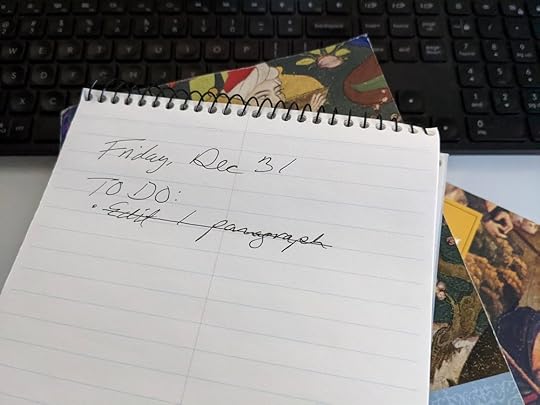
TO DO:
Edit 1 paragraph
Then I crossed the one thing off my to-do list and felt better.
Sometimes, finding a way to go on as a creative person means remembering why you create, and then doing the absolute minimum. It does not matter if you spend a whole hour on a single sentence. Authors fight their biggest battles against themselves. Deadlines fly past, computers break, editors say really mean things…but we are the ones who cause the most havoc in our creative process. The events at Christmas are surmountable, but my own mind was telling me that I was not capable of even attempting to overcome my trauma. When life also feels insurmountable, find the smallest thing you can accomplish, and do it. Then let yourself celebrate it.
I walked away from one paragraph and knew that I hadn’t lost my ability to write after all. The next day I edited two paragraphs. Today, I edited seven chapters. Perhaps tomorrow I will set an MVP to get my family back to their minimum as well.
November 30, 2021
Shopping for your bookish friends and family. Or for your bookish self.
I assembled this list because I really want all of these things and I hope that my husband will read it.
This is not a Christmas list. There are many occasions to celebrate giving and reading all year round: a birthday, an anniversary, or just because it is a story Saturday afternoon - the perfect kind for curling up with a good book. I’ve been assembling these bookish items in my various wishlists for a while and I think them appropriate for every time of year!
Book Alleys
Japan Old Town Mini Alley, by Techarge
A whimsical road that winds through your perfectly categorized and dusted bookshelves? Yes, please. This appeals to me in every possible way, including my childhood obsession with the fairy tale Thumbelina. If I had one of these I would probably sit and stare at it for hours, imagining myself strolling through that those crooked little streets. Book alleys (or book nooks) can be found all over the internet, but Etsy has some very nice ones.
A nerdy T-shirt from Inkwell Threads
I bought this one for myself because it summarizes my approach to reading and writing books all in three simple words. Here are a few other favorites from Inkwell Threads.
View fullsize
View fullsize [image error]
View fullsize
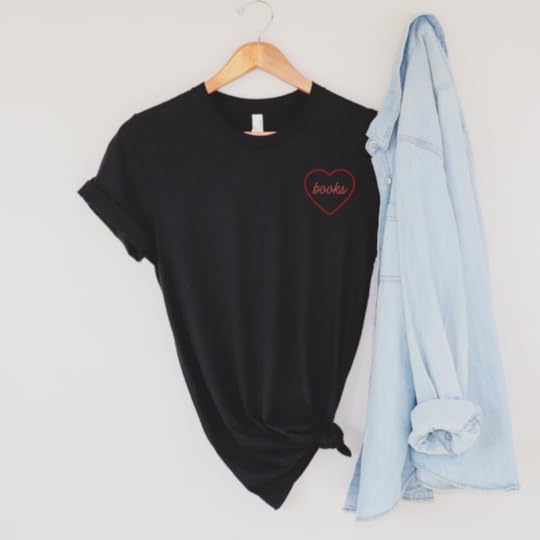
eReader cases that look like books.
It was a part of the eBook resistance for years because I love the feel and smell of real paper between my fingers. But after a business trip to London, where I hauled The Greenlanders by Jane Smiley on an 11-hour flight, I relented. When it finally occurred to me that my Kindle was another opportunity to accessorize, I was hooked. There are some great leather and vegan leather options on Etsy, where you can pimp out your eReader and support an independent artist along the way.

Skyrim Tome Case for a B&N Nook by TheSoGreat21
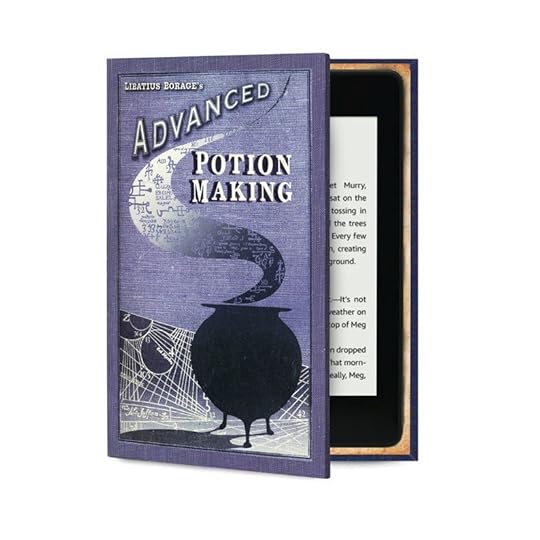
Kindle Case with Advanced Potions Cover, by KleverCase

I could’t find any Kobo Reader cases, but I did find this nice Kobo-Koozy by Modako
Book-Themed candle by Novelly Yours
The smell of an unexpected plot twist…
These candles are brilliant. I’m hesitant to purchase candles online because I prefer to smell them first, but the makers at Novelly Yours have great, detailed descriptions of their scents on their website. For example, Antique Bookshop smells of book pages, old paper, leather, and dust. I’m extremely allergic to dust, so I decided to pass, but Sci-Fi is completely intriguing because it apparently smells like fog, icy mint, steel, and moondust. I have absolutely idea what moondust smells like, but I’m 100% intrigued and I’m also 99% sure I’m not allergic!
Reading-Themed Art
I Saw Her In the Library, by Emily Winfield Martin
We can’t all have a library or dedicated reading nook in our homes, but for those of us who drool over images of book abundance, there is always a great painting or photo. Not only does Society6 have a good collection of book and reading art, but you can have it made into everything from a smartphone case to a shower curtain. There are also some amazing book art options on Etsy, Minted, Great Big Canvas, etc.

Literary Insults Chart at Uncommon Goods. I have this one hanging in my office.
Socks!
Literary Giants Pattern Socks by GrandeDuc
One cannot concentrate on reading a great story with cold feet. Keep your bookish loved one’s toes toasty with a pair of literary socks.
A gripping historical read with complex characters
The Scribe and The Land of God together make a great gift for Medieval history lovers!
I can’t leave these out! The Scribe and The Land of God are great for readers who are interested in a different perspective on the Middle Ages - one that starts outside of the Western world. Not recommended for sensitive readers or those under the age of 16.
November 14, 2021
Medieval Marginalia: Creepy Crawlies
Every month or so, I try to take a week to feature some of my favorite medieval marginalia. Marginalia, in its strictest form, refers to the little doodles and asides sketched into the margins of a medieval manuscript. Largely ignored for many years, and often nonsensical, marginalia is gaining attention because it not only shows how those scribe-monks let off steam, but it gives us a peek into what medieval people found humorous (hint: it usually has something to do with butts, things coming out of butts, and things being inserted in butts. So, the next time someone tries to say that the youth of today are vapid and gross, tell them about the medieval butt stuff.)
However, today I don’t want to talk about butts, I want to talk about insects. Insects do make it into medieval marginalia and into the more purposeful illuminations that can be found scrolling around a letter or a page illustration. The British Library’s Medieval Manuscript Blog pointed out that most of the insects found in marginalia were bees, possibly because they were an insect that offered something in return, whereas spiders and ants were just annoying. As you can see, some of these insect illustrations are absolutely stunning and show great attention to detail and a love of nature.

Detail of a folio from a prose treatise on the Seven Vices, with marginal spiders and a praying mantis, Italy (Genoa)
I highly encourage you to visit the British Library’s Catalogue of Illuminated Manuscripts to take a closer look at these. For more marginalia examples, please visit my marginalia Pinterest board, where I have collected some of my favorites.
[image error]
A six-legged spider and a ten-legged spider. I have made it my life's work to avoid spiders, and so I actually wasn't sure if it was possible for there to be a ten-legged spider…which meant, as a responsible researcher, I had to go look it up, which meant a Google search which meant PICTURES of spiders. AAAACCCKKK!
You’re welcome for doing this for you.
Arachnids have 8 legs. Period. The little devils can lose a leg or two, but they don't grow more than 8 at a time, so either the artists were not very observant or (more likely) they were too busy running away to get a good look at their subjects.

Detail of a miniature of bees guarding their hives against a marauding bear, from Flore de virtu e de costumi (Flowers of Virtue and of Custom), Italy, 2nd quarter of the 15th century
I love this one. The bees are like, "hey bear, how about we kill you and use your fur to insulate our hives? And the bear is like, "No thanks, bees!" Inspiration for the Berenstain Bears, perhaps?

Detail of a miniature of bees collecting nectar and returning to their hive, from a bestiary with theological texts, England, c. 1200 – c. 1210
My father is a beekeeper, which means that I spent my childhood being stung more than the other kids in my neighborhood, and I was forced to learn about the different kinds of hives. These pretty, cloche-shaped, braided hives are called skeps, and they have been around for over a thousand years. Another thing I like about this drawing is the way in which the bees are all traveling in the same pattern. This is something that bees actually do. It was an observant scribe who created this little bit of marginalia. :-)
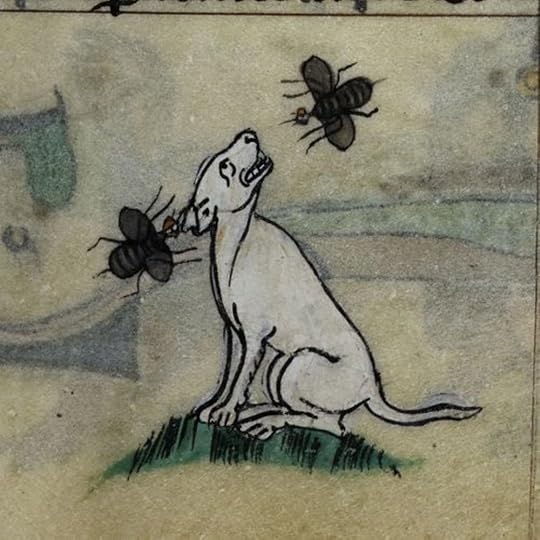
Detail of a marginal painting of flies surrounding a dog, from the Maastricht Hours, Netherlands (Liège), 1st quarter of the 14th century
This one bothers me because I don't like to see a dog being taunted, and these flies are jerks. What this dog needs is a murderous, medieval rabbit to ride to his rescue on a man-headed snail (see marginalia week, October 2021 on my Instagram).
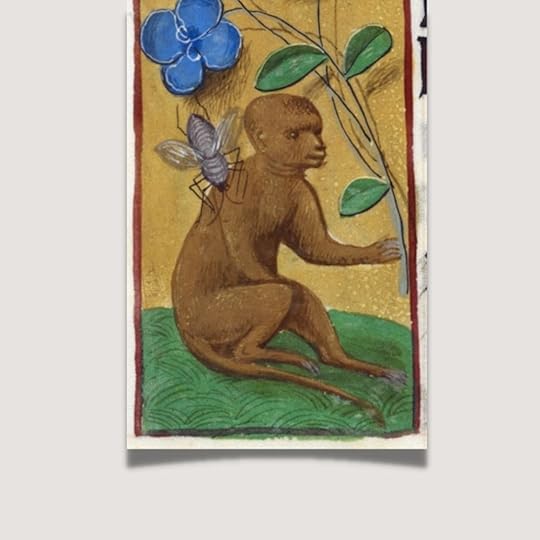
Another example of a fly being an asshole as it antagonizes a monkey. I dislike monkeys, having spent quite a lot of time in their company when I lived in southeast Asia, but this good-natured fellow doesn't deserve a sting.

Miniature of the Patriarch of Antioch being attacked by bees, from William of Tyre’s Histoire d’Outremer, France, 1232-1261
At first glance, it looks like the Patriarch of Antioch is being attacked by bees while his friends stand around and gossip about him. Upon more study, however, we learn that the patriarch of Antioch is tied up (notice the rope around his neck and hands) and he has been smeared in honey and set upon by a swarm in order to execute him. The gentleman in the foreground with upraised finger is Raynald of Châtillon, made infamous to modern audiences in the movie The Kingdom of Heaven. Yes, that Raynald of Châtillon. He was just as bad in real life as in the movie.

Je suis Raynald de Châtillon! Raynald de Châtillon!!!
And on and on. I love this kind of manuscript illustration because it provides me with an assurance that the world today is not terribly different than it was a thousand years ago. Bears still try to get honey and bees sting them. Spiders build webs, and butterflies sip from thistle blossoms. It’s these little bits of shared experience that make the past feel close enough to touch and see. It is evidence that a love of nature and a desire to create beauty is inherent in all of us.

Opinions and commentary are my own. Information about all of these marginalia examples, along with a more educated and less irreverent analysis, can be found in the British Library’s Medieval Manuscript Blog .



